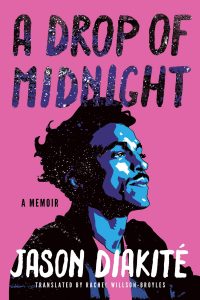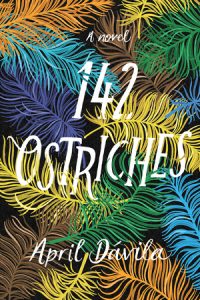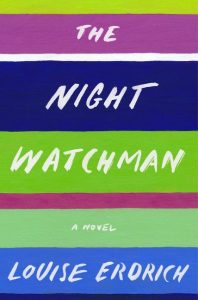
Eavesdropping changes lives (Wooster, Ohio, 1952 – 1953; backstory Depression years): Prussian Blue, considered a color of “cool intensity,” makes a perfect color choice for a luxurious hat purchased by the nosy, opinionated, passive-aggressive protagonist in The Operator: thirty-eight-year old Vivian Dalton whose resentment seethes below the surface of this deliciously gossipy and quirky story charmingly written by debut novelist Gretchen Berg. As an infidelity plot unwinds, Vivian’s anger bubbles over, reflecting a coolly intense tone.
Vivian, though, is not a charming person. (Nor is her aloof, silent husband Edward.) She resents a lot of things, like her nemesis, Betty Miller, whom she sees shopping through the windows of an expensive clothing shop, Beulah Bechtel, where Vivian splurged on that Prussian Blue hat. The store – located in a small fifties-era town, Wooster, Ohio “where everyone knew everyone else’s business – is one of many historical references that turn out to be true. The biggest comes as a delightful surprise at the end in the Author’s Note. Don’t peak. Read it after you finish as it will bring a smile.
Vivian is someone you’ll come to understand and root for, having felt tossed aside most of her life. And maybe again if what she’s heard listening in – eavesdropping – as a switchboard operator for Ohio Bell Telephone. The type of operator whose voice you would have heard back in the day when you picked up your phone to make a call but you couldn’t dial anyone directly. The operator had to connect you. She (of course she’s a woman) wasn’t supposed to listen in on the line, but human nature being what it is, especially for someone as bored and lonely as Vivian, she does.
It’s one thing to eavesdrop for gossip to entertain a hum-drum life, another when you hear Betty Miller tell someone on the other end with an unfamiliar voice about a rumor involving your husband of sixteen years. Stabs your heart when you have low self-esteem but take pride in “knowing people.” If what you heard is true, it means you’ve been married to a man you don’t know at all. Mortifying, since Vivian has worked hard to keep her life private. Distrusting, since she feels everyone has let her down.
Sixteen pages in you’ll have a good sense why what Vivian overheard “feels like the rug of her life has been yanked out from under her,” threatening everything she’s accepted as the best she could get, everything she depends on. It may not be much compared to the people she reads about in her celebrity magazines, her prime reading source as her mother taught her to be wary of books. If the scandal is true, she’ll have even less.
Granted it’s risky for Vivian to go poking around to pursue the truth – “be careful what you wish for” – but this time she cannot let bygones be bygones. She’s after the truth. We like truth-tellers. Vivian’s tale may be decades old, but it’s quite relevant today when truth is a precious commodity.
Vivian feels guilty for the extravagant hat purchase, but cherishes it because of the image it projects, having been poor all her life. Too poor to get an education beyond 8th grade, resentful of her family for depriving her of one. Too poor in the early years of her marriage for Edward to afford a telephone in their ramshackle first house. Resentful of that too, given her job is wired to that important communication device.
Adding fuel to the fire is that it was Betty spewing that awful gossip. Vivian never liked her. Betty is a rich, spoiled snob and a show-off, being the daughter of the town’s mayor, who made his money as the owner of the town’s bank. Petty, shallow, vindictive are other words to describe her. Worse, she’s a racist and ethnically prejudiced, condescending to “people forgetting their place.”
Vivian started eavesdropping at age ten with that “glass-pressed-on wall trick” we may have mischievously done when we were kids, making the novel a step back onto memory lane. You’ll love the old-fashioned talk. Remember when people used to say garsh? Highfalutin? But when it comes to unfaithfulness, betrayal, if that’s what it is, exposing secrets buried for years, Vivian’s story isn’t, sadly, out-of-date.
For young Vivian, all she wanted was for her mean older sister to include her when her cousins came to visit instead of always excluding her. Sandwiched in-between three other siblings, she was “perpetually craving attention.”
Perpetual is a big word for Vivian. So is Excruciating. Retribution. Oblivious. Words she doesn’t know, but looks up in the dictionary, shamed by her tenth-grade bright daughter, Charlotte. Words that are simply defined and quoted, breaking up paragraphs with dictionary definitions typeset differently from the rest of the prose using a ubiquitous font we used on manual typewriters, as if typed on index cards we remember too. Words that cleverly describe Vivian and her emotions. Berg shows us that you don’t need highfalutin words to express a character’s feelings.
Six months before the novel opens, the biggest news that’s come to this town is that Betty’s father’s bank was robbed of a quarter of a million dollars. He’s promised to pay everyone back. “When you’re as big a man as J. Ellis Reed, you had a responsibility to maintain a certain standing in your community.” So full of himself he irks us, just like Betty does.
Vivian, on the other hand, is grateful for her job that doesn’t pay well but gives her “independence and possibility, and her first taste of power.” More than that, it shows what the dignity of work means. How it gives someone a “sense of control” in a world “full of uncertainty.”
A hundred pages in, you’ll figure out what the Betty phone call conveyed and why it could ruin Vivian’s life. The small town feeds on her anxieties and fears. Consumed by them, Vivian finds solace in baking, using recipes our grandmothers used. She also soothes herself singing nursery rhymes and writing rhyming poems. All part of the sly, character-driven prose.
Vivian doesn’t reach out to people except superficially. She has no real friends, not even the gaggle of switchboard operators she works with every day. She observes them though, distantly.
Until one day she meets someone kind to her, a woman who repeats a pernicious theme: discrimination. Mexican, she’s the kind of person the Betties of her world would disregard, but the kind of person who pays attention to and cares about Vivian, so she’s someone Vivian can learn to trust, stretching herself to do that.
While Vivian presents as someone whose behavior may have been stunted due to traumas in childhood, what we see after Vivian’s earth-shattering eavesdropping is a Vivian who stretches herself to get to the bottom of Edward’s scandal. That makes us proud of her.
Vivian adopts a new persona as a determined and effective private eye, who finds the strength to get out of her mousy shell to unearth buried secrets. Only then does she begin to see that glass half-full rather than half-empty.
Along the way, someone tells Vivian why she loves small towns, the novel taking another stab at stereotypes. “They’ll never really surprise you, small town people, you know.”
But Vivian does surprise us on this swell journey to get unstuck.
Lorraine






